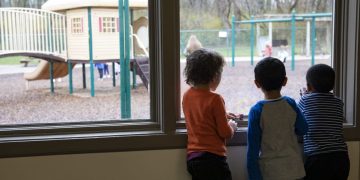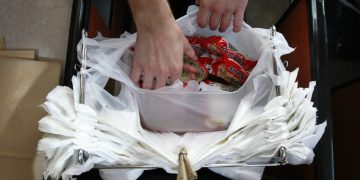‘Too early for victory laps’: Fed inflation fight looms over Biden
The next chapter of the Federal Reserve’s fight against inflation will stretch through the 2024 election, putting President Biden in a pinch as he campaigns on a yet-to-be-seen soft landing.
The central bank has walked a tightrope to cool the economy and bring down inflation without triggering a recession. The Fed began its battle with an aggressive series of rate hikes, then paused in September as inflation fell steadily over the past 18 months.
After its final meeting of the year concludes Wednesday, the Fed’s rate-setting committee will announce its next step in the fight against inflation after a year of remarkable progress.
While experts don’t expect the Fed to declare victory, they believe the bank is well on its way toward delivering a “soft landing” — a return to low inflation without a recession.
“The odds of a soft landing have certainly increased dramatically in recent months. There’s probably a better than 50-50 chance that we do get that very rare soft economic landing, but it’s too early for victory laps,” Greg McBride, chief financial analyst for Bankrate.com, told The Hill.
The U.S. economy is in a much better place than it was a year and a half ago, economists told The Hill, with inflation falling, strong economic growth and low unemployment.
The economy’s success came in the face of headwinds, including the spectacular collapse of Silicon Valley Bank and Signature Bank this spring, the resumption of student loan payments, the ongoing conflict in Ukraine and the war between Israel and Hamas.
“The U.S. economy is quite resilient. It has been the big story of this year,” Niladri Mukherjee, chief investment officer at TIAA Wealth Management, told The Hill.
Some economists argue the economy is already on track to see lower inflation without a recession, which was widely feared when the bank began hiking rates.
“In my opinion, the soft landing is in the bag,” Claudia Sahm, a former Fed economist and the founder of Sahm Consulting, told The Hill. She is best known as the creator of the “Sahm Rule,” an early warning recession indicator based on the three-month average national unemployment rate.
“We could sustain this labor market. The COVID disruptions, Ukraine disruption and inflation continue to work themselves out. That’s the path we’re on,” Sahm added. “That was not clear last year. Last year was really rough.”
Bidenomics and the 2024 presidential race
Inflation has fallen from its peak topping 9 percent in June 2022 to 3.1 percent in November, according to the latest consumer price index released Tuesday by the Labor Department. That’s still above the Fed’s 2 percent inflation target but within striking distance.
President Biden’s reelection campaign used last week’s jobs report, which showed higher-than-expected job gains, to make the case that he’s “cleaning up the economic disaster” left by his predecessor and presumed challenger in the 2024 race, former President Trump.
But it may be too soon to tell whether the economy is a winning message for Biden as the plane is still coming in for landing.
“This period of incredibly high inflation absolutely does not play well for Biden,” said Michelle Holder, an assistant economics professor at John Jay College.
While it looks like the U.S. economy is coming in for a soft landing, Americans remain concerned with high prices as they’re squeezed by higher borrowing costs. And even Democrats seem to have a hard time backing Biden’s economy.
A recent New York Times/Siena College poll of voters in six battleground states found 62 percent of Biden voters rated the economy “fair” or “poor.” Trump is leading Biden in five of those six battleground states, the poll found, though the hypothetical general election match-up is more than a year away.
While the economy is improving by many measures, many Americans are struggling. Those who enjoyed pandemic stimulus-padded safety nets are seeing those savings dwindle, and credit card, mortgage and auto payment delinquency rates have all risen as borrowing costs have ballooned.
“Sixty percent of U.S. households live paycheck to paycheck. The prices are 20 percent higher than they were pre-pandemic and for a lot of households, income hasn’t increased 20 percent,” McBride said.
“So buying power has been squeezed, budgets are tighter, savings has been eroded, credit card debt has been added, and that reality is weighing on millions of households,” he added.
Where the Fed goes from here
The Fed is widely expected to hold interest rates steady on Wednesday at a range of 5.25 percent to 5.5 percent, the range set by its most recent rate hike in July.
With rates at their highest level in more than two decades, Fed officials have been willing to sit back and watch the impact of their previous hikes before raising borrowing costs again.
Fed Chair Jerome Powell has also warned the bank could hike rates again in 2024 if inflation shows signs of reigniting.
“My firm base case throughout all of this is the Fed is going to get 2 percent [come] hell or high water,” Sahm said, noting “the Fed’s only tool is fewer customers.”
Even so, the steady decline of inflation and rising pressure on low-income households is prompting calls for the Fed to consider cutting rates.
“As the inflation rate declines, the Fed’s not going to be able to keep rates at current levels indefinitely,” McBride says. Rates that stay high for too long risk tipping the U.S. economy and labor market into a recession.
While a recent estimate by UBS Investment Bank forecasts rate cuts as soon as March, the central bank will have to balance bringing interest rates down without tipping the economy into a recession.
Interest rate hikes target the demand side of the economy, dampening it by jacking up borrowing costs. But that doesn’t tell the full story.
“The misdiagnosis here was the assumption that inflation was largely demand, rather than supply, driven,” Moody’s Analytics Deputy Chief Economist Cristian deRitis told The Hill.
“Fed policy kept inflation from accelerating further by keeping demand in check, but most of the decline in inflation is attributable to improvements in the supply side of the economy.”
Mukherjee warned that if the Fed cuts interest rates too quickly, economic growth could reaccelerate and cause the Fed to reverse course and hike rates that the market is expecting to see cut.
“Everybody’s extrapolating too far up the path of no recession,” Mukherjee said. “That’s what makes it risky for investors.”
Holder said that, “The way to go is to be slow, steady and modest in order to mitigate these feedback effects with higher shelter costs and the very real feedback effect of you raise interest rates, you slow down the labor market, unemployment increases.”
A labor economist who studies women and people of color in the labor market, Holder noted Black workers in particular are experiencing historically low levels of unemployment.
“I do hope the Fed stays the course and continues along this path that has led us to be in this vein of a soft landing because I don’t want to see the gains that Black workers have made be reversed,” Holder said.
Despite a slew of high-profile layoffs, particularly in the technology sector, the national unemployment rate has remained below 4 percent for the longest stretch in decades, edging down to 3.7 percent in November.
“The biggest dynamic that is still at play is the Federal Reserve and the labor market. It’s literally been these are the two fronts which are fighting each other and we will at some point know which direction the fight is breaking,” Mukherjee said. “And you could argue that will have a big say in who wins the next year’s election as well.”
Whether the economy will tip the election in Biden’s favor, or whether Americans will even credit him with a soft landing should it materialize, remains to be seen.
“Whether or not I believe this is going to make or break Biden, or actually break Biden, in terms of his presidential bid, I’m not ready to say that,” Holder said. “I’m not ready to say that inflation is the straw that broke the camel’s back.”
regular post copyright









